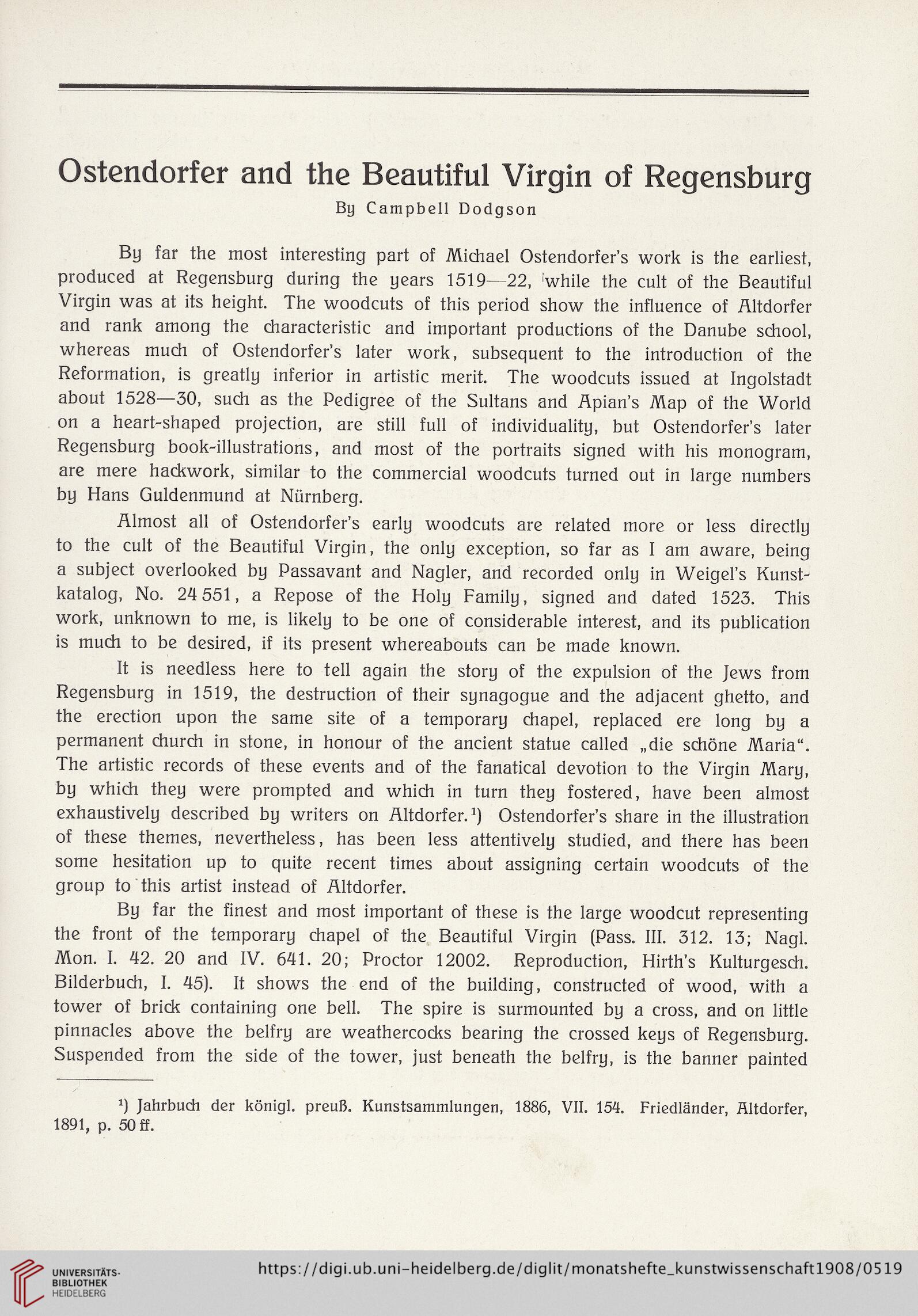Ostendorfer and the Beautiful Virgin of Regensburg
By Campbell Dodgson
By far the most interesting part of Michael Ostendorfer's work is the earliest,
produced at Regensburg during the years 1519—22, 'while the cult of the Beautiful
Virgin was at its height. The woodcuts of this period show the influence of Altdorfer
and rank among the characteristic and important productions of the Danube school,
whereas much of Ostendorfer's later work, subsequent to the introduction of the
Reformation, is greatly inferior in artistic merit. The woodcuts issued at Ingolstadt
about 1528—30, such as the Pedigree of the Sultans and Apian's Map of the World
on a heart-shaped projection, are still full of individuality, but Ostendorfer's later
Regensburg book-illustrations, and most of the portraits signed with his monogram,
are mere hackwork, similar to the commercial woodcuts turned out in large numbers
by Hans Guldenmund at Nürnberg.
Almost all of Ostendorfer's early woodcuts are related more or less directly
to the cult of the Beautiful Virgin, the only exception, so far as I am aware, being
a subject overlooked by Passavant and Nagler, and recorded only in Weigel's Kunst-
katalog, No. 24 551, a Repose of the Holy Family, signed and dated 1523. This
work, unknown to me, is likely to be one of considerable interest, and its publication
is much to be desired, if its present whereabouts can be made known.
It is needless here to teil again the story of the expulsion of the Jews from
Regensburg in 1519, the destruction of their synagogue and the adjacent ghetto, and
the erection upon the same site of a temporary chapel, replaced ere long by a
permanent church in stone, in honour of the ancient statue called „die schöne Maria".
The artistic records of these events and of the fanatical devotion to the Virgin Mary,
by which they were prompted and which in turn they fostered, have been almost
exhaustively described by writers on Altdorfer.1) Ostendorfer's share in the illustration
of these themes, nevertheless, has been less attentively studied, and there has been
some hesitation up to quite recent times about assigning certain woodcuts of the
group to this artist instead of Altdorfer.
By far the finest and most important of these is the large woodcut representing
the front of the temporary chapel of the Beautiful Virgin (Pass. III. 312. 13; Nagl.
Mon. I. 42. 20 and IV. 641. 20; Proctor 12002. Reproduction, Hirth's Kulturgesch.
Bilderbuch, I. 45). It shows the end of the building, constructed of wood, with a
tower of brick containing one bell. The spire is surmounted by a cross, and on little
pinnacles above the belfry are weathercocks bearing the crossed keys of Regensburg.
Suspended from the side of the tower, just beneath the belfry, is the banner painted
9 Jahrbuch der königl. preuß. Kunstsammlungen, 1886, VII. 154. Friedländer, Altdorfer,
1891, p. 50 ff.
By Campbell Dodgson
By far the most interesting part of Michael Ostendorfer's work is the earliest,
produced at Regensburg during the years 1519—22, 'while the cult of the Beautiful
Virgin was at its height. The woodcuts of this period show the influence of Altdorfer
and rank among the characteristic and important productions of the Danube school,
whereas much of Ostendorfer's later work, subsequent to the introduction of the
Reformation, is greatly inferior in artistic merit. The woodcuts issued at Ingolstadt
about 1528—30, such as the Pedigree of the Sultans and Apian's Map of the World
on a heart-shaped projection, are still full of individuality, but Ostendorfer's later
Regensburg book-illustrations, and most of the portraits signed with his monogram,
are mere hackwork, similar to the commercial woodcuts turned out in large numbers
by Hans Guldenmund at Nürnberg.
Almost all of Ostendorfer's early woodcuts are related more or less directly
to the cult of the Beautiful Virgin, the only exception, so far as I am aware, being
a subject overlooked by Passavant and Nagler, and recorded only in Weigel's Kunst-
katalog, No. 24 551, a Repose of the Holy Family, signed and dated 1523. This
work, unknown to me, is likely to be one of considerable interest, and its publication
is much to be desired, if its present whereabouts can be made known.
It is needless here to teil again the story of the expulsion of the Jews from
Regensburg in 1519, the destruction of their synagogue and the adjacent ghetto, and
the erection upon the same site of a temporary chapel, replaced ere long by a
permanent church in stone, in honour of the ancient statue called „die schöne Maria".
The artistic records of these events and of the fanatical devotion to the Virgin Mary,
by which they were prompted and which in turn they fostered, have been almost
exhaustively described by writers on Altdorfer.1) Ostendorfer's share in the illustration
of these themes, nevertheless, has been less attentively studied, and there has been
some hesitation up to quite recent times about assigning certain woodcuts of the
group to this artist instead of Altdorfer.
By far the finest and most important of these is the large woodcut representing
the front of the temporary chapel of the Beautiful Virgin (Pass. III. 312. 13; Nagl.
Mon. I. 42. 20 and IV. 641. 20; Proctor 12002. Reproduction, Hirth's Kulturgesch.
Bilderbuch, I. 45). It shows the end of the building, constructed of wood, with a
tower of brick containing one bell. The spire is surmounted by a cross, and on little
pinnacles above the belfry are weathercocks bearing the crossed keys of Regensburg.
Suspended from the side of the tower, just beneath the belfry, is the banner painted
9 Jahrbuch der königl. preuß. Kunstsammlungen, 1886, VII. 154. Friedländer, Altdorfer,
1891, p. 50 ff.




